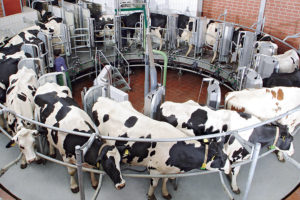 When cooling raw milk, every degree in temperature above 40°F (4°C) elevates bacteria counts and decreases the shelf life. Close temperature control, clean milk, and sanitary equipment help many dairymen earn quality premiums and avoid penalties based on reduced bacteria counts.
When cooling raw milk, every degree in temperature above 40°F (4°C) elevates bacteria counts and decreases the shelf life. Close temperature control, clean milk, and sanitary equipment help many dairymen earn quality premiums and avoid penalties based on reduced bacteria counts.
According to Pasteurized Milk Ordinance (PMO) regulations, the raw milk total bacteria count (TBC) sold to processors must be less than 100,000 cfu/ml. To achieve this, dairymen must cool the 95-99°F raw milk quickly to 40°F (4°C) within 30 minutes after the first milking ends, hold the milk in a bulk tank at 37-38°F (3°C), and prevent temperatures from rising above 45°F any time after four hours after the start of the milking or during the addition of milk from subsequent milkings.
Cooling Options
Typically, cooling requirements are achieved with a refrigerated tank or through a plate cooler. Water chillers are commonly involved to bring the milk temperature down quickly. The chilled coolant is circulated through the heat exchangers, jacketed vessels, or in-line coolers.
Using the Glen Dimplex Thermal Solutions (GDTS) chiller design, dairymen can depend on their milk staying precisely at the temperature required even with variable milk loads. For more than 60 years, GDTS has been designing chillers for the industrial market, where heat loads vary, ambient temperatures are extreme, and temperature stability is critical.
Chiller specifications are usually based on steady-state performance. This occurs once the system has reached a stable temperature and a constant heat load is established. In the milking process, significant temperature changes occur, requiring advanced chiller capabilities able to handle dynamic changes through a well-designed control strategy. This may include responsive, low thermal mass sensors and intelligent logic for the desired performance.
Chiller Designs
The simplest way to accommodate fluctuations is to turn the compressor on and off. While low cost, this approach places an upper limit on system precision. It also creates a potential for premature compressor failure. Frequent start-stop cycles lead to significant wear and tear from increased exposure to motor inrush currents and inadequate distribution of compressor lubricant.
Using multiple compressors is a great alternative and the design choice for the Glen Dimplex Thermal Solutions P Series modular chiller.
This design method can improve temperature regulation, particularly in partial-load conditions including variable flows of milk during the milking process. Modulating cooling capacity by staging compressors in a multi-compressor system to match the rate of change in the process heat loads improves overall control system response. In addition, this approach can increase system reliability by balancing run hours amongst the available compressors.
Understanding your cooling needs is the first step in achieving precise temperature control; partnering with an experienced chiller manufacturer is the second. To learn more about Glen Dimplex Thermal Solutions’ expertise and chillers, visit www.dimplexthermal.com/contact-us/ or call (800) 968-5665.
Sources:
- Proper Cooling of Milk on Dairy Farms, American Dairymen (https://www.americandairymen.com/articles/proper-cooling-milk-dairy-farms)
- Chiller Selection: Balancing Precision and Cost, Process Cooling (https://www.process-cooling.com/articles/88967-chiller-selection-balancing-precision-and-cost?v=preview)
- Dairy Farm Energy Efficiency, milkproduction.com (http://www.milkproduction.com/Library/Scientific-articles/Management/Dairy-farm-energy-efficiency/)





